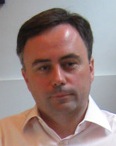ジョン・グラハム=カミング
表示
(ジョン・グラハム・カミングから転送)
| ジョン・グラハム=カミング | |
|---|---|
 | |
| 研究機関 | Cloudflareのプログラマ[1] |
| 出身校 | オックスフォード大学 |
| 博士論文 | The formal development of secure systems (1992) |
| 博士課程 指導教員 | Jeff W. Sanders |
|
公式サイト www | |
| プロジェクト:人物伝 | |
ジョン・グラハム=カミング(英: John Graham-Cumming)は、イギリスのプログラマ、作家である[2]。アラン・チューリングに対する迫害の謝罪を求め提出し、実現させた請願で知られている[3]。2017年現在、Cloudflareの最高技術責任者である。
彼は、オープンソース・クロスプラットフォームの電子メールフィルタリングソフトウェアである、POPFile の原作者である[4]。執筆活動として、旅行本の The Geek Atlas[5]と、GNU Makeの技術書である GNU Make Unleashed を著している[6] 。
2010年10月、彼は、バベッジの解析機関を作り上げる[7][8][9][10]ことを目的とした組織の Plan 28[11]を立ち上げた。また、科学分野におけるオープンソースソフトウェアの推進活動をしている[12]。2014年には、映画作品中に登場したソースコードと現実世界のコードを結びつけることを意図したミニブログ、 MovieCodeを開設した[13]。
出典
[編集]- ^ “John Graham-Cumming on Polyglot Programming and Geek History”. C4Media Inc.. 17 May 2016閲覧。
- ^ “John Graham-Cumming”. London: The Guardian. (2010年3月1日) 2013年10月3日閲覧。
- ^ “Petition seeks apology for Enigma code-breaker Turing - CNN.com”. Edition.cnn.com. (2009年9月1日) 2013年10月3日閲覧。
- ^ Schechter, Bruce (8 March 2003). “Spambusters”. NewScientist 3 November 2013閲覧。
- ^ John Graham-Cumming (2009). The Geek Atlas: 128 Places Where Science and Technology Come Alive. Sebastopol, CA: O'Reilly Media, Inc. ISBN 0-596-52320-3
- ^ Graham-Cumming, John (2008). GNU Make Unleashed
- ^ Fildes, Jonathan (2010年10月14日). “BBC News - Campaign builds to construct Babbage Analytical Engine”. Bbc.co.uk 2013年10月3日閲覧。
- ^ Graham, Duncan. “A £400,000 PC downgrade: Rebooting Babbage’s Analytical Engine (Wired UK)”. Wired.co.uk. 2013年10月3日閲覧。
- ^ “The Greatest Machine That Never Was: John Graham-Cumming at TEDxImperialCollege”. YouTube (2012年4月26日). 2013年10月3日閲覧。
- ^ “John Graham-Cumming: The greatest machine that never was | Video on”. Ted.com. 2013年10月3日閲覧。
- ^ “Plan 28: Building Charles Babbage's Analytical Engine”. 2012年7月24日閲覧。
- ^ Ince, D. C.; Hatton, L.; Graham-Cumming, J. (2012). “The case for open computer programs”. Nature 482 (7386): 485–488. doi:10.1038/nature10836. PMID 22358837.
- ^ Johnson, Phil (8 January 2014). “The sources of all that code you see in TV and movies”. ITworld 13 January 2014閲覧。
